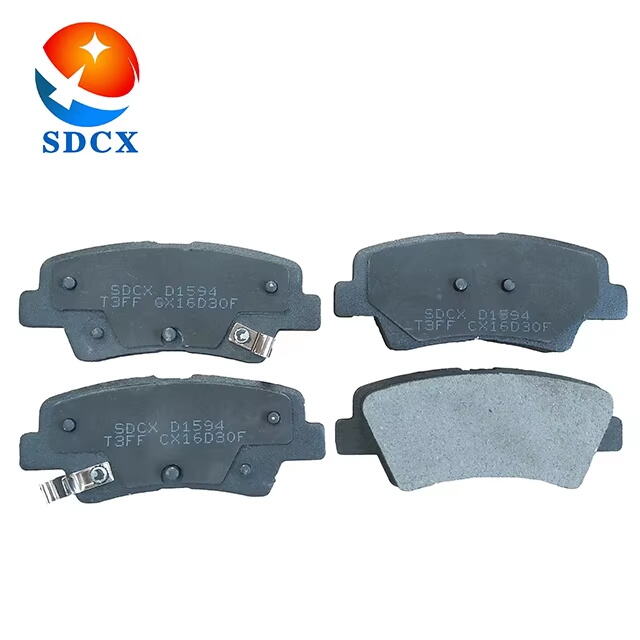The Critical Role of Brakes in Vehicle Safety
Proper functionality of brakes is crucial for vehicle safety, as they are responsible for stopping a vehicle effectively, thereby allowing drivers to maintain control and prevent accidents. According to the National Highway Traffic Safety Administration (NHTSA), brake-related issues contribute to 22% of car crashes, highlighting the significance of well-maintained brakes in reducing collision risks [National Highway Traffic Safety Administration]. The braking system consists of interconnected components such as rotors, calipers, and brake pads—all playing unique roles that collectively ensure safe driving. For instance, brake pads apply pressure to rotors to create friction, stopping the vehicle while calipers hold the pads firmly in place. Understanding these components not only emphasizes their importance in brake safety but also promotes responsible vehicle maintenance practices.
Consequences of Incorrect Installation: Real-World Examples
Incorrect brake pad installation can lead to severe consequences, as illustrated by real-world examples. A case study involving Rona Cardwell demonstrated the dangers of improper installation when her aftermarket brake pads were incorrectly placed, causing her vehicle to swerve dangerously during braking. The repair costs were substantial, as she had to pay an additional $500 to a Mercedes-Benz dealer to correct the error [KENS 5 News]. Improper installation not only leads to frequent malfunctions but results in financial burdens due to repair costs and potential liabilities. Expert testimonies highlight common pitfalls such as mismatched pads and negligence in checking fitment, proving that attention to detail and precision during installation are vital to avoid costly mishaps and ensure reliable brake performance.
Long-Term Benefits of Following OEM Specifications
Adhering to OEM specifications during brake pad installations offers significant long-term benefits. OEM standards ensure compatibility and optimal performance, extending the lifespan of brake components such as pads and rotors. By following manufacturer guidelines, one reduces the risk of premature wear and tear, subsequently minimizing the need for frequent replacements and repairs. This adherence to OEM specs results in more reliable vehicle performance, fostering driver confidence both in daily commutes and emergency situations. With OEM brake pads, drivers experience consistent and safe braking, ultimately elevating the overall driving experience through enhanced safety and assurance.
Essential Tools and Materials for Auto Brake Pad Installation
Must-Have Tools: Jack, Lug Wrench, and C-Clamp
When installing auto brake pads, certain tools are essential to do the job safely and effectively. A jack is needed to lift your vehicle off the ground, providing access to the wheel and brake assembly. For safety, choose a jack with sufficient weight-bearing capabilities for your specific vehicle model. The lug wrench is crucial for loosening and tightening the bolts that secure the wheels. Properly using a lug wrench involves turning it counterclockwise to loosen and clockwise to tighten. A C-clamp is indispensable for compressing the brake caliper piston, a critical step before installing new brake pads. Ensure that each tool is durable and robust to withstand repeated use. Prioritize safety by stabilizing the vehicle securely with the jack and using wheel chocks to prevent unwanted movement during installation.
Optional but Helpful: Brake Grease and Anti-Seize Compound
While not mandatory, the use of brake grease can significantly reduce noise and prevent corrosion on brake components. Applying a thin layer of brake grease on the back of the brake pads helps minimize squeaking, enhancing overall brake performance. Anti-seize compounds are beneficial in preventing parts from seizing together due to heat and friction. This compound ensures that future maintenance tasks are easier, as components will be less likely to bind. Technical experts recommend applying anti-seize lightly on the metal-to-metal contact points, making future disassembly and replacements hassle-free. Both materials serve to extend the life of your brake system and ensure its reliability.
Safety Gear: Gloves, Goggles, and Wheel Chocks
Implementing personal protective equipment (PPE) is paramount in automotive work, particularly during brake pad installation. Safety gear such as gloves and goggles protect against cuts, chemical injuries, and debris. Opt for reinforced, cut-resistant gloves and shatterproof goggles to ensure comprehensive protection. Moreover, wheel chocks are vital for stabilizing your vehicle, preventing it from rolling during the repair process. Always place chocks on both sides of a wheel opposite to the one being worked on, enhancing security and peace of mind. By prioritizing safety protocols and protective gear, you significantly minimize the risk of accidents and injuries during auto brake pad installations.
Step-by-Step Guide to Installing Auto Brake Pads
Step 1: Safely Lift the Vehicle and Remove the Wheel
Start by ensuring the vehicle is parked on a stable, flat surface to prevent any accidents during the lifting process. Use a reliable jack to lift the vehicle securely. Position the jack according to the manufacturer's designated lift points to avoid damaging the vehicle's frame. Once the vehicle is lifted, it's crucial to place jack stands under the vehicle for added safety. These stands provide additional support and reduce the risk of the vehicle collapsing while you work. Removing the wheel involves loosening the lug nuts with a lug wrench and carefully taking the wheel off to access the brake components.
Step 2: Remove Caliper and Extract Old Brake Pads
To access the old brake pads, the caliper must first be detached carefully. Use a wrench to unbolt the caliper, ensuring not to damage the brake lines or other components. It's advisable to hang the caliper with a piece of wire to prevent strain on the brake hose. When extracting old brake pads, inspect them for signs of uneven wear, as this could indicate issues with the braking system. Be cautious during this process, avoiding contact with the brake fluid as it can be harmful. Common mistakes include misplacing caliper bolts or neglecting to check for additional wear on connected components, which could compromise brake performance.
Step 3: Compressing the Caliper Piston Correctly
Properly compressing the caliper piston is an essential step. Use a C-clamp or a caliper piston tool to apply even pressure across the piston, ensuring it retracts without causing damage. Improper compression can lead to uneven wear on new brake pads or could prevent the caliper from functioning correctly. It's also prudent to check for any signs of brake fluid leaks or damage around the caliper during this step, as these could lead to further problems down the line.
Step 4: Preparing the Caliper Bracket and Rotor Surface
Before installing new brake pads, clean the rotor surfaces and caliper brackets thoroughly. Use a brake-specific cleaning solution or lubrication to clear debris and corrosion without compromising brake efficiency. This ensures optimal contact between the rotor and brake components, improving performance. Inspect the rotor for any warping or damage that could affect safety. Addressing any issues before proceeding will save time and enhance the reliability of the brake installation.
Step 5: Installing New Pads and Reassembling Components
Installing new brake pads involves aligning them correctly with the caliper, ensuring they fit snugly into the caliper bracket. Take a systematic approach to reassemble the caliper and any removed components, checking each step for proper alignment and secure fastening. Once reassembled, conduct a final check to confirm all components are installed correctly, including ensuring that the caliper bolts are tight and the brake line is intact. Before lowering the vehicle, double-check everything to ensure safety and functionality with your new brake pads.
Avoiding Common Auto Brake Installation Mistakes
Mistake 1: Incorrect Brake Pad Orientation
Installing brake pads incorrectly can lead to uneven wear and compromise safety. When brake pads face the wrong direction, they may not contact the rotors properly, leading to inefficient braking and possible safety issues. Many DIY enthusiasts misalign the pads by not paying close attention during the installation. For instance, some may install the wear indicator on the wrong side, creating issues with fit and function. To avoid such errors, always refer to the vehicle's service manual for guidance on positioning the pads correctly. Experts also advise marking the orientation of the old pads before removal to ensure consistent placement when installing the new set. Proper orientation is vital to avoiding premature wear or inefficient brake performance.
Mistake 2: Improper Caliper Piston Compression
Failing to compress the caliper piston correctly can result in dragging brakes or overheating, significantly affecting vehicle performance and safety. When the piston isn't compressed uniformly, it could cause the brake pads to remain slightly engaged, leading to excessive heat generation and potential damage. Real-world examples include Cases where improper compression causes the new, thicker brake pads not to fit, leading to inefficient performance. To ensure effective compression, use a C-clamp or a specialized brake caliper compression tool, applying slow, even pressure across the piston. This technique not only helps in maintaining brake performance but also reduces the risk of damage to essential braking components.
FAQ
Why is proper brake pad installation important for vehicle safety?
Proper installation ensures the brakes function correctly, which is crucial for stopping the vehicle effectively and preventing accidents. Well-installed brake pads help maintain control and ensure safe driving conditions.
What are the consequences of incorrect brake pad installation?
Incorrect installation can lead to a failure of the braking system, increased wear and tear, potential accidents, and higher repair costs. It can also cause inefficient braking, leading to safety risks.
What tools are necessary for installing brake pads?
Essential tools include a jack, lug wrench, and C-clamp. Optional tools like brake grease and anti-seize compound can enhance the installation and performance of the brake components.
How can I avoid common mistakes in brake pad installation?
Refer to the service manual for guidance, ensure proper orientation of the pads, and use the correct tools for compressing the caliper piston. Mark the orientation of old pads to help with correct placement.

